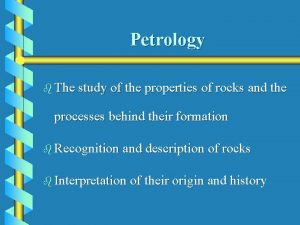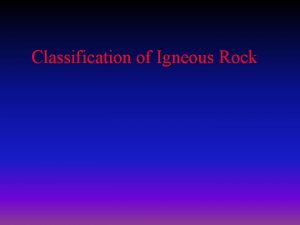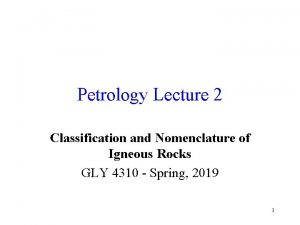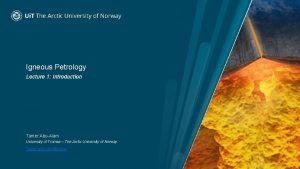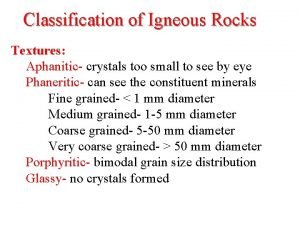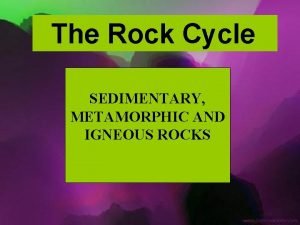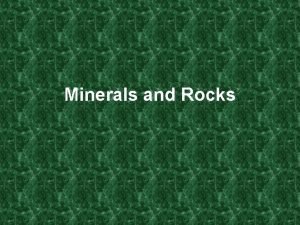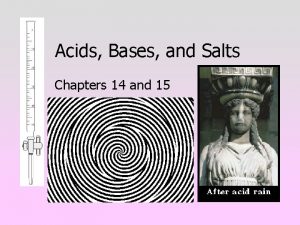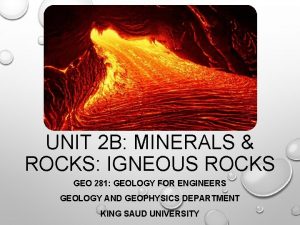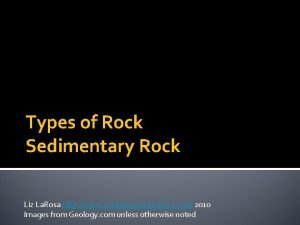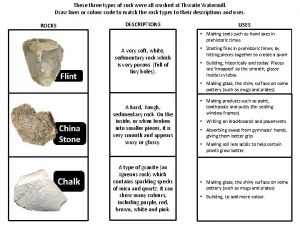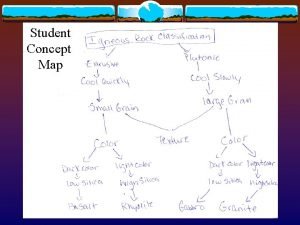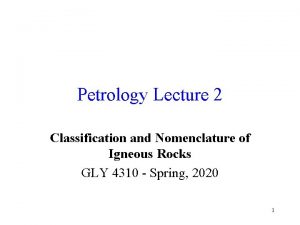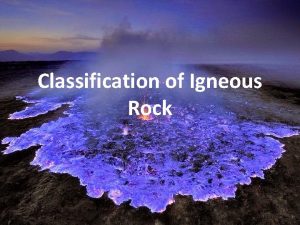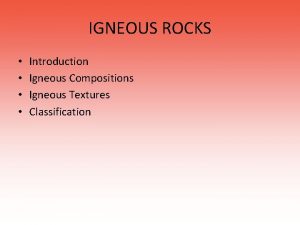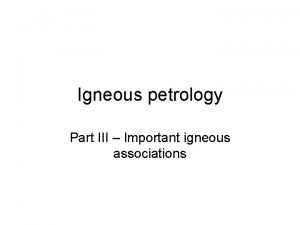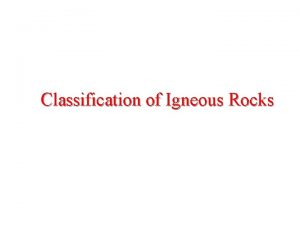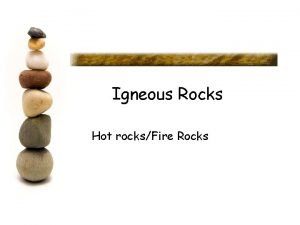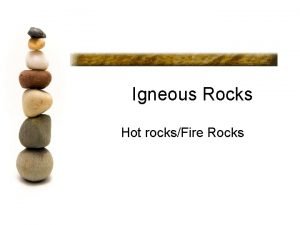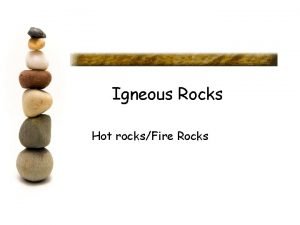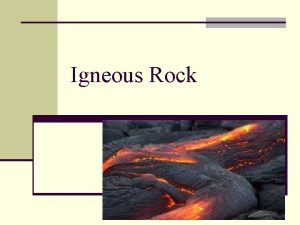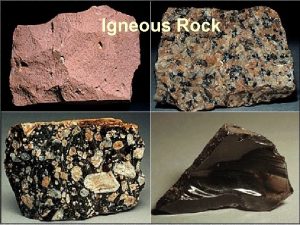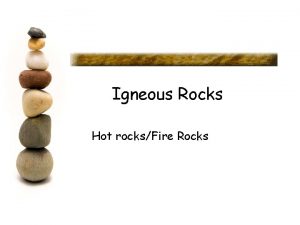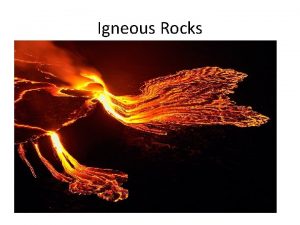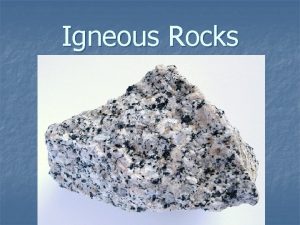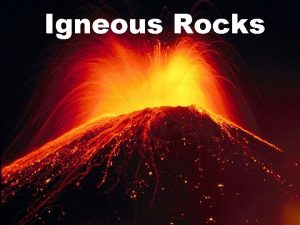Petrology Lecture 2 Classification and Nomenclature of Igneous























- Slides: 23

Petrology Lecture 2 Classification and Nomenclature of Igneous Rocks GLY 4310 - Spring, 2019 1

Igneous Textures • Phaneritic: Crystals are readily visible with the unaided eye. • Aphanitic: Crystals, if present, are too small to be seen with the unaided eye. • Fragmental: Composed of pieces of pre-existing, mostly igneous, rock, crystal fragments, and/or glass. These pieces were deposited and later amalgamated into a rock. 2

Porphyritic Size Distribution • Porphyritic - bimodal size distribution, with large grains surrounded by numerous small grains or glass • Phenocrysts - Large crystals formed by relatively slow cooling below the earth’s surface • Groundmass - Small crystals or glass, formed by more rapid cooling 3

Composition • Felsic: Rocks composed primarily of silica-rich minerals, generally feldspars and silica, from which the term is derived. Common minerals include plagioclase feldspar, alkali feldspar, quartz, and muscovite. The term can be used to modify either a mineral or a rock name. • Mafic: Rocks rich in magnesium and iron, and hence with lower silica contents. Common minerals include olivine, pyroxene, hornblende or other amphiboles, and biotite. The term can be used to modify either a mineral or a rock name. 4

Types of Minerals • Essential – Minerals which must be present in order for a rock to be classified with a certain name • Accessory – Minerals need not be present in a rock, but which may be present in small amounts 5

Chemical Composition Classification • • Felsic (acidic) Intermediate Mafic (basic) Ultramafic (ultrabasic) > 66 wt. % Si. O 2 52 -66 wt. % Si. O 2 45 -52 wt. % Si. O 2 < 45 wt. % Si. O 2 6

Alumina Saturation 7

Color Index 8

Using IUGS Classification • 1. Determine the mode – by determining the volume percent of several classes of minerals: § § § a. Q = % quartz (rarely, other silica phases) b. P = % plagioclase, An 05 -100 c. A = % alkali feldspar (K-spar and An 00 -05) d. F = % feldspathoids (often called foids) e. M = % mafics and accessories 9

Using IUGS Classification II • 2. Determine Q + A + P or F + A + P • 3. Determine if the rock is phaneritic (intrusive) or aphanitic (extrusive) 10

IUGS Classification • Phaneritic rocks 11

IUGS Classification • Aphanitic Rocks 12

Using IUGS Classification III • 4. Determine the name of the rock from the diagram • 5. If P + M (gabbroic) >90% or M > 90% (ultramafic), different classification schemes are used 13

IUGS Classification • Gabbroic rocks 14

IUGS Classification • Ultramafic Rocks 15

IUGS Classification • Phaneritic rocks 16

Aphanetic Rocks • In principle, we follow the same steps for volcanic rocks as we do for intrusive rocks • However, the nature of the aphanitic rocks makes determination of the mode difficult, especially in hand specimen • Even in thin section, groundmass material may be too small to recognize, or may be amorphous • Phenotypes – based on phenocrysts only 17

“P” Apex Classification • Again, rocks near the “P” apex are troublesome. § Andesite may be defined as a plagioclase-rich rock with Si. O 2 > 52%, or a color index < 35% § Basalt has Si. O 2 < 52%, or a color index > 35%. 18

IUGS Classification • Chemical classification of volcanic rocks 19

Problems with Pyroclastics • These rocks present special problems, because they often contain significant impurities (material blasted out by the eruption, or caught in the general updraft) • In principle, they can be classified on the basis of a chemical analysis, but the presence of significant impurities argues against this approach 20

IUGS Classification • Pyroclastic rocks • Based on type of fragmental material 21

IUGS Classification • Pyroclastic rocks • Based on fragment size § Ash < 2 mm § Lapilli 2 -64 mm § Blocks or bombs >64 mm 22

Web Resource • The preceding was a very short outline of igneous rock classification – for those students wanting more information, the following is a good resource: • http: //www. sepmstrata. org/page. aspx? pageid=593 § Includes flow charts designed to aid in igneous rock classification 23
 Petrology is the study of
Petrology is the study of 01:640:244 lecture notes - lecture 15: plat, idah, farad
01:640:244 lecture notes - lecture 15: plat, idah, farad Rock
Rock Aphanetic
Aphanetic Tamer abu-alam
Tamer abu-alam Iugs classification of igneous rocks
Iugs classification of igneous rocks Bayesian classification in data mining lecture notes
Bayesian classification in data mining lecture notes Types of igneous rock
Types of igneous rock What is the metamorphic rock cycle
What is the metamorphic rock cycle Igneous rocks metamorphic rocks and sedimentary rocks
Igneous rocks metamorphic rocks and sedimentary rocks Luster and streak
Luster and streak Is igneous rock intrusive or extrusive
Is igneous rock intrusive or extrusive Intrusive vs extrusive igneous rocks
Intrusive vs extrusive igneous rocks Concept map of igneous sedimentary and metamorphic rocks
Concept map of igneous sedimentary and metamorphic rocks Foliated rock
Foliated rock Illustration of rock cycle
Illustration of rock cycle What are the seven strong acids
What are the seven strong acids Manifold tabulation
Manifold tabulation I
I Concept map for igneous rocks
Concept map for igneous rocks What is massive igneous rock
What is massive igneous rock Three types of igneous rocks
Three types of igneous rocks Sedimentary concept map
Sedimentary concept map Igneous
Igneous
